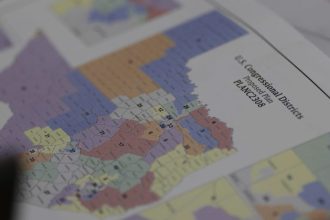The Indiana Statehouse on Sept. 18, 2025. (Whitney Downard/Indiana Capital Chronicle)
More of Indiana’s state agencies are earning approval for their mandatory expense-shrinking strategies — albeit with varying levels of enthusiasm.
Some have warned the effective 10% cuts could jeopardize statutorily required work, while others concluded their filings with cheery mantras.
“We realize that it is not about equal giving but equal sacrifice across our great state government agencies because we are ‘#INThisTogether,’” Department of Revenue leaders wrote. “We appreciate the partnership with the State Budget Agency and understand the monumental task that has been thrust upon you to provide the necessary guidance that will ultimately help stabilize our state government’s finances.”
A grim May revenue forecast prompted lawmakers to cut most agency appropriations by 5% in the latest budget — and authorized the State Budget Agency to withhold another 5%.
Agencies were required to describe how they’ll meet that target in “strategic spending reduction plans” due at the end of June. Gradually, they’re nabbing the go-ahead, and their filings are being uploaded.
Indiana Fiscal Policy Institute President Stephanie Wells celebrated the reports’ public availability.
Indiana Fiscal Policy Institute President Stephanie Wells speaks at the organization’s annual luncheon, held at Newfields in Indianapolis on Tuesday, Sept. 16, 2025. (Leslie Bonilla Muñiz/Indiana Capital Chronicle)
“More transparency is always better — more data and more information on the decisions of Hoosier government is our preference,” Wells said, though she noted that “some are a little bit more informative than others.”
There’s a long way to go, however. Indiana is less than three months into its two-year budget; the fiscal year began July 1.
“I hope that they continue to report on the impact the holdback has made to the delivery of government services over the course of the biennium,” Wells said.
Personnel preoccupations
Many agencies with labor-intensive responsibilities noted almost all their budgets are spent on employees — leaving little room to slash expenses without reducing headcount.
The Office of Inspector General, for instance, reported that salaries and benefits account for 92% of operational costs. The office advises and investigates alleged wrongdoing to reduce fraud, waste and abuse in Indiana’s executive branch agencies.
“Despite efforts to minimize the impact, these budget cuts will inevitably affect the OIG’s ability to fully serve its core mission,” leaders wrote.
OIG successfully requested an exemption from the 5% reserve standard.
Others are taking the hit.
The State Personnel Department — the government’s human resources arm — and the Office of Administrative Law Proceedings also expend 92% of operational dollars on staff.
They planned to meet the reserve requirement with stringent, near-identically worded “position management strateg(ies).”
“Newly vacant positions will undergo formal review by (agency) leadership to determine if the position is critical or non-critical to operations,” their spending plans read. “Where appropriate, we will attempt to collapse the responsibilities and functions of vacant positions into existing positions, programs, or teams” before seeking to fill the roles.
Critical jobs can be filled — but first, must be vacant for at least 30 calendar days before posting.
“This will ensure at least 60-90+ days of cost savings,” the plans read.
Non-critical positions will be “deactivated” or kept vacant. If empty roles are still considered non-critical after 90 days, they’ll also be deactivated.
It’s unclear if all agencies are subject to this policy.
“Agencies weren’t directed to include a position management strategy in spending plans specifically. However, they were asked to address staffing with the expectation that requests for compensation or classification reviews would be factored into spending plans,” an SBA spokesperson said. “SPD is focused on helping agencies with strategic workforce management.”
The Department of Workforce Development is also downsizing.
It was dealt a whopping 27% cut in the budget, according to a Fiscal Policy Institute analysis, before the additional 5% reserve requirement. It also had a “sudden and unforeseen” federal funding drop.

Indiana Gov. Mike Braun speaks at a Department of Workforce Development event on Tuesday, Sept. 16, 2025. (Courtesy Office of the Governor)
Leaders, in their plan, explained that DWD’s funding and workload run “countercyclical” to the economy.
“In times of economic downturn, federal funding increases significantly; in times of economic growth, federal funding tapers off,” they wrote. “However, the associated workload of economic downturns, such as the COVID-19 pandemic, often last(s) well beyond” the extra money’s end.
The agency’s workforce peaked in 2022 at about 1,300 employees but has since dropped. “Further reductions” are coming.
Leaders estimated a staff of less than 900 in 2025, but are “targeting pre-pandemic staffing-level costs.” Headcount hit a low of about 800 in 2020.
“That’s sort of indicative of how much — not all — of government works: you have to hire individuals to do the work,” Wells said. “… Personnel is, I wouldn’t say, the easiest place to cut, but it’s the most logical place to cut.”
The role reductions and vacancy policies are “very reminiscent of what was done during the Great Recession at a state level,” she said. She worked for former Gov. Mitch Daniels’ administration during that time period.
“What I’ll be interested to see is when that stops — when we get back to the baseline, and then we slowly start to bring folks back into government and replace open positions in a more standard way,” Wells continued. “And that may not be this biennium. We’ll just have to see.”
Uniquely enough, the Public Access Counselor’s Office is betting on past underspending to “cut” costs. The office provides guidance on state public records and open meeting laws.
Former Counselor Luke Britt said his longtime deputy and administrative assistant left partway through 2024. He resigned in February this year. Gov. Mike Braun appointed new Counselor Jennifer Ruby in March.
“This office should not have fully used its payroll allocation,” Ruby wrote, but will need to spend to address its backlog.
Other savings strategies include having the Office of Administrative Law Proceedings pay for a part-time, temporary legal intern, and a part-time paralegal through next June.
Still, she asked for a waiver from the 5% reserve in order to pay for a senior attorney — who would “still be paid below average.”
Meeting that requirement would force the salary to an entry-level amount, Ruby explained. “This … would leave our office with no deputy PAC to support the operations to meet our requirements under Indiana law.”
Other entities primarily make grants. In its plan, the Commission for Higher Education celebrated that administrative costs are just 2% of spending in fiscal year 2026 — “well below the 4-5% industry standard.”
Contractor considerations
Agencies were required to take a hard look at their contract expenses in their spending plans. Some brought contracted tasks in-house.
The Department of Revenue, for instance, will take over paper check scanning for the Department of Child Services when its current vendor agreement expires in November, saving between $200,000 and $300,000 annually.
DOR also plans to seek legislation “dramatically” reducing mailing requirements, like limiting the number of attempts to resend returned mail, and by letting Hoosiers opt into e-notices. The agency hopes to cut $1.75 million from its annual $3.5 million in mail expenses.
But there’s still plenty of uncertainty.
“A potential risk to our plan” is the legislator-authorized tax amnesty program, which is to be conducted before the end of next year. DOR asked for an exemption from the 5% reserve to fund that. “An additional risk” is that the agency may absorb all administrative functions for the Child Support Bureau.
Meanwhile, data-centric Management Performance Hub doesn’t have enough money to cover Informatica functions past March.

The Indiana Management and Performance Hub focuses on data-based efficiency. (Screenshot of website)
“We will be discussing ownership with (the Indiana Office of Technology), and agency stakeholders to determine the best way forward,” leaders wrote.
MPH also requested to hold $350,000 from the amount reverted to the General Fund at the end of last fiscal year. The agency is rushing to migrate its databases from one vendor to another before the end of the year to avoid pricey consequences. The move is expected to cost $400,000 to $600,000.
Missing that deadline would cost MPH an additional $490,000 to $610,000 in annual renewals. But to finish it all in time, the agency might need to lean on the vendors or other contractors — to the tune of between $200,000 and $250,000.
The State Board of Accounts was also hard-hit. The auditing entity’s workload increased 30% during the pandemic, and that won’t let up until the end of 2027, according to the spending plan.
That’s because the influx of federal spending came with new federal audit requirements and push many local governments past a federal spending threshold that triggered more audits.
“Reduced funding will directly lead to a reduction in the number of examinations that the SBOA can complete,” agency leaders warned.
Need to get in touch?
Have a news tip?
To deal with the work, SBOA contracted private examiners. But to complete all statutorily required audits without contractors, the agency would need about 30 more field examiners.
The spending plan listed challenges: a “significant reduction” in college accounting majors, the lowest number of Certified Public Accountant candidates in over a decade and experienced accountants leaving the field.
SBOA also reported struggling to stay competitive with private sector starting salaries — and dealing with the “targeted recruitment of our most experienced auditors by private firms and other governmental units.”
The agency has no layoffs planned. It’ll keep hunting for new additions instead, and any reductions in staff will be based on attrition.
Exemption efforts
Requests for exemptions from the 5% reserve or other fiscal requirements were commonplace among the spending plans approved thus far.
For Wells, that’s to be expected.
“Of course, you’re going to ask for exemptions, as an agency director, where you can,” she said, “so that your operations can continue to function at a high manner.
“You might shoot your shot, as it will, and see what you can get.”
The Indiana Department of Health successfully requested an exemption to fund the licensing and surveying of healthcare facilities, according to the spending plan. That includes 173 hospitals, 157 ambulatory surgery centers, 225 residential care facilities, 246 home health agencies, 97 hospice agencies, 43 blood centers, seven birthing centers, and approximately 3,000 personal care services agencies.
The agency also makes recommendations on certifications for about 510 nursing homes, 6,900 laboratories, 161 end stage renal disease facilities, 46 outpatient rehabilitation facilities, 151 rural health clinics, and much more.
IDOH leaders said the agency wouldn’t be able to complete high-importance surveys quickly enough for the federal Centers for Medicare and Medicaid Services — “which could lead to them cutting agency funding to even lower levels.”
Not every waiver request is granted.
IDOH asked for an exemption from the Statewide Cost Allocation Plan, citing cuts in the federal funding that typically makes up a lot of the agency’s budget. The agency expects to owe the state $1.5 million in fiscal year 2026 because it is two years in arrears and because personnel expenses have increased.
The Indiana State Police also submitted a spate of exemption requests — some of which were granted, some in-progress and some seemingly denied.

Indiana State Police Superintendent Anthony Scott tours an ISP garage alongside Gov. Mike Braun on Friday, Aug. 29, 2025, in Indianapolis. (Casey Smith/Indiana Capital Chronicle)
ISP was one of the few agencies that got more money out of lawmakers. But some of its accounts still got cut, including Forensic and Health Sciences Laboratories, the Indiana Intelligence Fusion Center and Indiana Operating/Motor Carrier Inspection. Those escaped the 5% reserve requirement.
Some money for drug interdiction and DNA sample processing will be held from the agency’s planning budget.
Leaders submitted several pages of detailed expense-cutting strategies, like bringing radio repairs in-house; fueling at ISP posts “when practical,” “avoiding excessive idling” and “always using 87 octane fuel.”
SUBSCRIBE: GET THE MORNING HEADLINES DELIVERED TO YOUR INBOX









